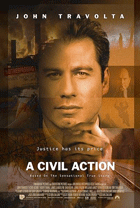 Director: Steven Zaillian
Director: Steven Zaillian
Duration: 115 minutes
Year: 1998
Key words: Environmental pollution and crime, legal action
Summary: Lawyer Jan Schlichtmann fights to hold a local leather factory responsible for the deaths and illnesses of a number of children and adults in Woburn (Massachusetts, USA) from leukaemia.
Degree of public health theme coverage: This is a drama “based on a true story” about a legal case against companies implicated in land/water contamination that was linked to a cluster of leukaemia cases in a town in the USA. The major theme is really about the legal case and how the key lawyer runs the case (Jan Schlichtmann). He shifts from being caring for just the money to one concerned about the people who were harmed. But the movie is also partly about some public health issues. These include:
- Business behaviour (ie, burying drums of waste, hiding burial sites from inspectors and removing waste before inspections, denying responsibility, being a major employer in a town, destruction of old documents, putting land under a Trust). How the companies are trying to win so as to prevent being subject to future claims by other personal injury lawyers. Ultimately the courts found that the tannery owner deliberately concealed evidence at the trial and one of the companies was “indicted by a Grand Jury for false statements to the EPA [Environmental Protection Agency] regarding its use of the chemicals TCE, acetone and toluene”. Both the tannery and the Grace plant were closed down in 1990.
- The difficulty of using (USA) law to address this type of complex problem is revealed. But ultimately a more powerful agency (the EPA) does win (the lawyer (Jan) sent them all the information from the case). The EPA settled for clean-up costs of $69.4 million – the biggest cleanup in New England history.
- The issues around what is a cluster of cases (and how talking to people can elicit relevant info eg, on the chlorine taste of the earlier water). Score=3/5
Sophistication of analysis of public health content: The movie shows the complexity and the huge cost of conducting such a case. It also indicates EPA involvement at the end. But public health officials were largely not mentioned (some inspectors had been to the plant but had been mislead). The reactions of the victims and workers seem to be well covered and are appropriately nuanced. However, the actual link between the chemical exposure and the leukaemia cases is not discussed.Score=3/5
Potential for empowerment and use of advocacy: This movie is partly a case study of the potential use of the law to expose an environmental health issue and to force industry to respond (eg, apology, clean-up, compensation) but it showed how this was largely unsuccessful initially (ie, bankrupted the law firm involved and only achieved a modest level of compensation for the families – ie, no apology and no cleanup). The judge was portrayed as having various biases against the case proceeding – so this can be interpreted as a disturbing system failure of the US justice system. The judge also didn't accept an appeal when new evidence emerged near the end of the cleanup.
Ultimately the EPA action did force the companies to pay for a clean-up – so that does provide some indication of a partially successful long-term outcome. Due to big differences in legal systems around the world it is not very clear how generalisable such action would be in other countries. Score=2/5
Persuasiveness of the movie: The movie is fairly persuasive given that it is based on real events (this is stated at the start of the movie). The behaviour of the various parties seems fairly credible, though the behaviour of the judge might be considered a bit bizarre (eg, he required the jury to answer very complex questions). The high level of persistence and personal commitment required for the legal team seemed huge, so perhaps this seems a rather unusual response. Indeed most such cases in the US system would normally have been settled out of court for a smaller sum. Also the key lawyer (Jan) seems somewhat reckless with money and also regarding his personal well-being – so this is possibly a bit unrealistic. The Beatrice lawyer was very cynical about the justice system having nothing to do with truth. Perhaps he was too cynical? Score=3/5
Engagement and cinematic quality: The movie is engaging with very good acting. The plot flow is fast paced.Score=4/5
Total score = 15/25
Questions for discussion:
- What was the range of business responses to this environmental health problem?
- How typical are these responses of corporations?
- Does this movie inspire your faith in the use of the justice system to address these type of problems?
Other information:
- There is a Wikipedia article on this movie - found here
- There is also some interesting commentary at this website
- A best selling book of the same name was written by Jonathan Harr.
- The trailer can be seen on YouTube - found here
- Back to Films in Undergraduate Public Health Teaching home page
CONTACT US
Associate Professor Nick Wilson
Department of Public Health
University of Otago, Wellington
PO Box 7343
Wellington South 6242
New Zealand
Tel: +64 4 385 5541 ext 6469
Fax: +64 4 389 5319
Email: nick.wilson@otago.ac.nz